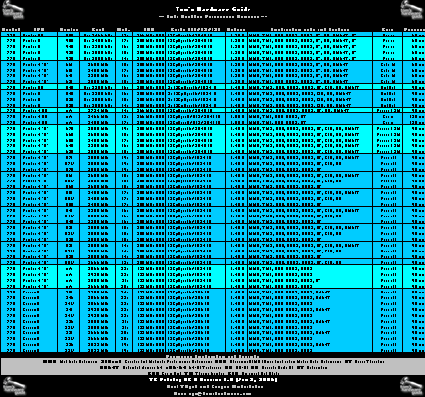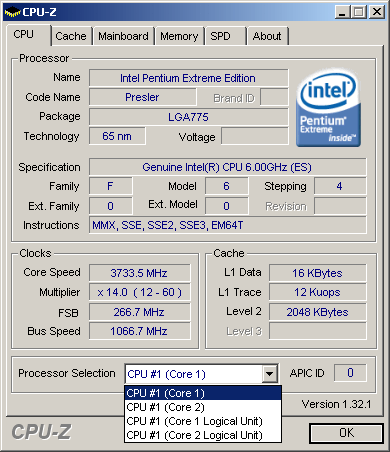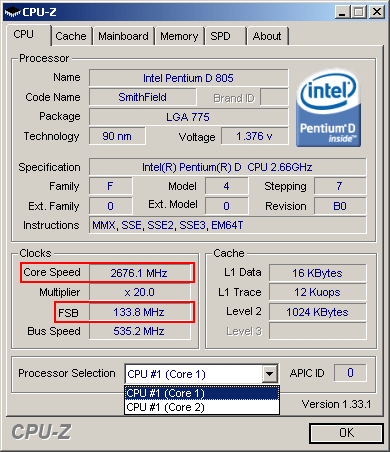A 4.1 GHz Dual Core at $130 - Can it be True?
The Secret Of The Multiplier
The multiplier expresses the ratio between the processor clock speed and the FSB clock. For the Pentium D 805, the combination of FSB and processor clocks results in a multiplier value of 20x. By comparison with other CPUs with 200 MHz or 266 MHz FSB, this is a very high value - 12x and 14x are much more common. But this also makes the Pentium D 805 a good candidate for overclocking. Simply by raising the FSB clock rate to 200 MHz, the resulting CPU clock rate rises to 4.0 GHz once the 20x multiplier is applied (20x times 200 MHz equals 4.0 GHz).
You can peruse a list of all currently used multiplier values in our Intel Desktop Processor Overview chart.
An overview of all Intel CPUs back to the Socket 5 era (1993).
By default, the top-of-the-line Extreme Edition 965 uses a multiplier of 14x.
The multiplier for the Extreme Edition 965 can be set in the BIOS anywhere from 12x to 60x, but such capability comes at a high price. This CPU costs around $1,100, which few users can afford to spend just on one component. This is yet another reason why those who buy a high-end CPU should also consider investing the time and effort involved in overclocking.
The 20x multiplier is burned into the CPU and may not be altered using a special BIOS, nor with a hardware jumper on the motherboard.
Since the D 805's multiplier is fixed, there's only one way to overclock it: by increasing the clock speed for the front side bus.
Get Tom's Hardware's best news and in-depth reviews, straight to your inbox.
Current page: The Secret Of The Multiplier
Prev Page Inside the Pentium D 805 Next Page 133 MHz FSB: Perfect For OverclockingTom's Hardware is the leading destination for hardcore computer enthusiasts. We cover everything from processors to 3D printers, single-board computers, SSDs and high-end gaming rigs, empowering readers to make the most of the tech they love, keep up on the latest developments and buy the right gear. Our staff has more than 100 years of combined experience covering news, solving tech problems and reviewing components and systems.
-
Tnias I am quite interested in your post regarding the D 805. Considering that it is now available for around $60.00 (03/20/09), it still sounds like a steal. We just upgraded our Adobe CS2 software to the new CS4 Master Suite, which caused the need for a graphics card upgrade. We have an nVidia GeForce GTX 260, but haven't installed it because our computer is a HP Media Center PCm7350n computers each with a 2.8 GHz CPU on a ASUS P5LP-LE mobo. Your article seemed to imply that there is software available that might adjust the clock from inside windows and we are wondering if it can on that mobo or if we will have to get a different mobo. If so, we are wondering what might be our most cost effective but stable options. We are certainly going to need a new power supply for the GTX 260, which requires 525 Watts. We are looking at just putting in PC Power & Cooling’s, Silencer 610 EPS12V power supplyand letting it go at that, but we are also thinking about upgrading the CPU and mobo if necessary.Reply
Of course, we would like to keep the cost down as much as possible.
We have no idea where the best bang for the buck will be. For us a stable system is more important than blazing speed. Thus, the HP's worked fine for what we originally got them for; it’s just that our graphics and video production software are forcing upgrades in speed and power.
The D850 chip sounds incredible and the power supply we already have to get will handle overclocking that chip. It even sounds like that chip will work in the existing mobo if we can find a way to change the clock speed from inside windows instead of from the BIOS. HP BIOS does not allow adjusting the clock speed in the BIOS but can't BIOS just be changed as well; isn't it just an EPROM?
Anyway, even if we opt for changing out the mobo for another case compatible Asus mobo, we still have to answer the question of which board and chip combination will give us the most stable service for the least cost.
Any ideas that might help us plan the most appropriate upgrade and the least cost? -
amnotanoobie TniasAny ideas that might help us plan the most appropriate upgrade and the least cost?Reply
With the price of components that you need to make this run stable, and the amount of electricity that this would use, a cheap Core 2 and motherboard and DDR2 memory would cost you less in the long run.
Example:
Intel Pentium Dual Core E5200
Kingston DDR2 2x2GB 800MHz
Gigabyte G31M-ES2C
This should cost less than $200.



